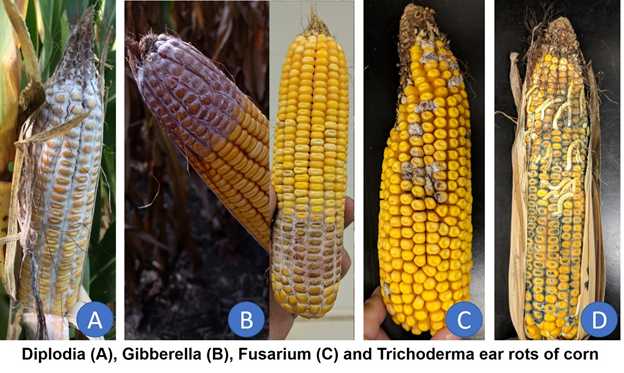August 29, 2018

Source: Ohio State University
By Pierce Paul, Felipe Dalla Lana da Silva
Over the last few weeks, we have received samples with at least four different types of ear rots – Diplodia, Gibberella, Fusarium, and Trichoderma. Of these, Diplodia ear rot seems to be the most prevalent. Ear rots differ from each other in terms of the damage they cause (their symptoms), the toxins they produce, and the specific conditions under which they develop. Most are favored by wet, humid conditions during silk emergence (R1) and just prior to harvest. But they vary in their temperature requirements, with most being restricted my excessively warm conditions such as the 90+ F forecasted for the next several days. However, it should be noted that even when conditions are not optimum for ear rot development, mycotoxins may accumulate in infected ears.
A good first step for determining whether you have an ear rot problem is to walk fields between dough and black-layer, before plants start drying down, and observe the ears. The husks of affected ears usually appear partially or completely dead (dry and bleached), often with tinges of the color of the mycelium, spores, or spore-bearing structures of fungus causing the disease. Depending on the severity of the disease, the leaf attached to the base of the diseased ear (the ear leaf) may also die and droop, causing affected plants to stick out between healthy plants with normal, green ear leaves. Peel back the husk and examine suspect ears for typical ear rot symptoms. You can count the number of moldy ears out of ever 50 ears examined, at multiple locations across the field to determine the severity of the problem.
DIPLODIA EAR ROT
This is one of the most common ear diseases of corn in Ohio. The most characteristic symptom and the easiest way to tell Diplodia ear rot apart from other ear diseases such as Gibberella and Fusarium ear rots is the presence of white mycelium of the fungus growing over and between kernels, usually starting from the base of the ear. Under highly favorable weather conditions, entire ears may become colonized, turn grayish-brown in color and lightweight (mummified), with kernels, cobs, and ear leaves that are rotted and soft. Rotted kernels may germinate prematurely, particularly if the ears remain upright after physiological maturity. Corn is most susceptible to infection at and up to three weeks after R1. Wet conditions and moderate temperatures during this period favor infection and disease development, and the disease tends to be most severe in no-till or reduce-till fields of corn planted after corn. The greatest impact of this disease is grain yield and quality reduction. Mycotoxins have not been associated with this disease in US, although animals often refuse to consume moldy grain.
GIBBERELLA EAR ROT
When natural early-season infections occur via the silk, Gibberella ear rot typically develops as white to pink mold covering the tip to the upper half of the ear. However, infections may also occur at the base of the ear, causing the whitish-pink diseased kernels to develop from the base of the ear upwards. This is particularly true if ears dry down in an upright position and it rains during the weeks leading up to harvest. The Gibberella ear rot fungus may also infect via wounds made by birds or insects, which leads to the mold developing wherever the damage occurs. When severe, Gibberella ear rot is a major concern because the fungus produces several mycotoxins, including deoxynivalenol (vomitoxin), that are harmful to livestock. Once the ear is infected by the fungus, these mycotoxins may be present even if no visual symptoms of the disease are detected. Hogs are particularly sensitive to vomitoxin. Therefore the FDA advisory level for vomitoxin in corn to be fed to hogs is 5 ppm and this is not to exceed 20% of the diet.
FUSARIUM EAR ROT
Fusarium ear rot is especially common in fields with bird or insect damage to the ears. Affected ears usually have individual diseased kernels scattered over the ear or in small clusters (associated with insect damage) among healthy-looking kernels. The fungus appears as a whitish mold and infected kernels sometimes develop a brownish discoloration with light-colored streaks (called starburst). Several different Fusarium species are associated with Fusarium ear rot, some of which produce toxins called Fumonisins. Horses are particularly sensitive to Fumonisins, but cattle and sheep are relatively insensitive.
TRICHODERMA EAR ROT
Abundant, thick, greenish mold growing on and between the kernels make Trichoderma ear rot very easy to distinguish from Diplodia, Fusarium, and Gibberella ear rots. However, other greenish ear rots such as Cladosporium, Penicillium and Aspergillus may sometimes be mistaken for Trichoderma ear rot. Like several of the other ear rots, diseased ears are commonly associated with bird, insect, or other types of damage. Another very characteristic feature of Trichoderma ear rots is sprouting (premature germination of the grain on the ear in the field). Although some species of Trichoderma may produce mycotoxins, these toxins are usually not found in Trichoderma-affected ears under our growing conditions.
You May Also Like




